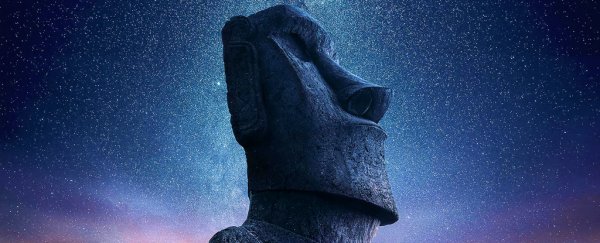For hundreds of years, they stood watch in silence: the 'moai', a mysterious league of almost 1,000 carved monolithic statues, erected across the isolated landscape of Easter Island (Rapa Nui).
Just how these towering idols came to be has long fascinated researchers – as have the customs and collapse of the Polynesian society that engineered them – but the symbolic relevance of the figures themselves has never been fully understood.
Now, an international study offers fresh insights into what the moai could have represented to the islanders who toiled to quarry and carve the giant effigies.
 Excavation and analysis at the site of two moai in Rano Raraku as part of the study. (Easter Island Statue Project)
Excavation and analysis at the site of two moai in Rano Raraku as part of the study. (Easter Island Statue Project)
Over 90 percent of the moai statues were produced in a quarry called Rano Raraku: a volcanic crater that at its base makes up less than 1 percent of the island's overall area, but nonetheless served as the single source of stone used to make the island's megalithic sculptural objects.
Yet there's more to Rano Raraku than just rock, the researchers say, based on an analysis of soil samples taken in the region.
"When we got the chemistry results back, I did a double take," explains geoarchaeologist Sarah Sherwood from the University of the South in Sewanee, Tennessee.
"There were really high levels of things that I never would have thought would be there, such as calcium and phosphorous. The soil chemistry showed high levels of elements that are key to plant growth and essential for high yields."
According to the research team, the established view of the quarry region is that it was an industrial site used to produce and temporarily store the moai prior to removal and transportation to other locations across the island.
Yet almost 400 of the monoliths remain in the quarry, and some are buried in the soil with support from fortified rock structures that suggest the placement is not temporary. The reason why, the researchers say, could be this uniquely rich soil.
"Everywhere else on the island the soil was being quickly worn out, eroding, being leeched of elements that feed plants," Sherwood says.
"But in the quarry, with its constant new influx of small fragments of the bedrock generated by the quarrying process, there is a perfect feedback system of water, natural fertiliser and nutrients."
In addition to evidence of the soil fertility, the researchers also found traces of ancient crops in the samples, including banana, taro, sweet potato, and paper mulberry.
These are all signs, the researchers think, that in addition to using the quarry for moai production, the Rapa Nui society also utilised the space as a place to grow foods they needed, leveraging the Rano Raraku's rich, tilled soils, which would have produced higher yields with lower labour costs.
"We venture the novel suggestion that based on these data, and on the ritualisation of Rano Raraku and its stone as megalithic resources, Rano Raraku soil/sediment itself was a valuable and protected commodity," the authors explain in their paper.
"Soil could have been transported from Rano Raraku to enrich those areas needing increased productivity."
It's a compelling case, but why were the moai also erected within the crater, amidst the land from which they were themselves produced?
It's long been theorised that the ceremonial purpose of the monoliths was associated with fertility rituals, and the researchers say their fieldwork provides chemistry-based evidence of this link – not to mention the discovery of the carved pits, suggesting the moai were likely erected to stand watch over these verdant gardens indefinitely.
"This study radically alters the idea that all standing statues in Rano Raraku were simply awaiting transport out of the quarry," says archaeologist Jo Anne Van Tilburg from UCLA.
"These and probably other upright moai in Rano Raraku were retained in place to ensure the sacred nature of the quarry itself. The moai were central to the idea of fertility, and in Rapa Nui belief their presence here stimulated agricultural food production."
The findings are reported in the Journal of Archaeological Science.
